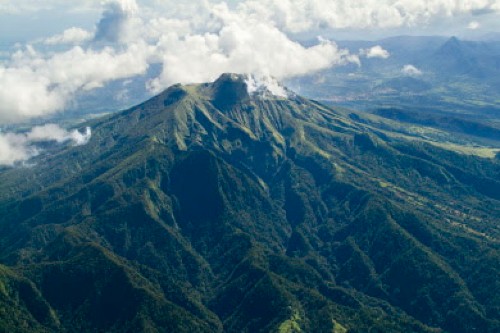OECS Welcomes Martinique’s World Heritage Site Designation by UNESCO
CASTRIES, St. Lucia – The Volcanoes and Forests of Mount Pelée and the Pitons of Northern Martinique have become the third World Heritage site in the Caribbean region after it was given the designation by UNESCO last weekend.
 Mount Pelee (OECS photo)It joins the Pitons Management Area in St. Luci and Morne Trois Pitons National Park in Dominica.
Mount Pelee (OECS photo)It joins the Pitons Management Area in St. Luci and Morne Trois Pitons National Park in Dominica.
Director General of the Organisation of Eastern Caribbean States (OECS) congratulated Martinique on achieving the designation as a UNESCO World Heritage site, saying “OECS member states have a rich, diverse, and unique history that reverberates through our mountains and valleys”.
He said that the sub-regional grouping of which the French island enjoys associate membership is “therefore happy that Montagne Pelée and the Northern Pitons have joined the Pitons in St. Lucia and Dominica’s Morne Trois Pitons National Park inscription under the natural category, along with the other sites around the world to share our stories”.
On September 16, a French delegation had presented its case to the 45th UNESCO World Heritage Committee, which met in Saudi Arabia, for Montagne Pelée and Pitons du Carbet’s inclusion to the revered list. Last Saturday, the jury concluded with the approval of Martinique’s candidacy.
Currently, there are 1,184 World Heritage sites in 166 countries across the globe, with three situated in the Caribbean region.
Two other sites in the OECS are inscribed under the cultural category – Antigua and Barbuda’s Naval Dockyard and Related Archaeological Sites and St. Kitts and Nevis’ Brimstone Hill Fortress National Park.
At the July meeting of the OECS Council of Ministers for Environmental Sustainability, OECS member states had reaffirmed support to Martinique in their candidacy towards World Heritage inscription on the UNESCO World Heritage list.
According to UNESCO, the global importance of Montagnet Pelée and the Pitons du Carbet is based on the representation of volcanic elements, materials and processes. The eruption of 1902-1905 is considered a key event in the history of volcanology which had dramatic consequences for the town of Saint-Pierre, resulting in the tragic loss of lives and a heritage which is part of the culture of Martinique.
Globally threatened species are found in this serial property, including the Martinique allobate (Allobates chalcopis), the common snake (Erythrolamprus cursor) and the endemic Martinique oriole (Icterus bonana).
“The United Nations Educational, Scientific and Cultural Organization (UNESCO) seeks to encourage the identification, protection and preservation of cultural and natural heritage around the world considered to be of outstanding value to humanity. This is embodied in an international treaty called the Convention concerning the Protection of the World Cultural and Natural Heritage, adopted by UNESCO in 1972”
According to the Convention, Cultural and Natural Heritage could be monuments, groups of buildings, sites including archaeological, historical, and aesthetic sites, natural features, geological and physiological formations, and natural sites.


